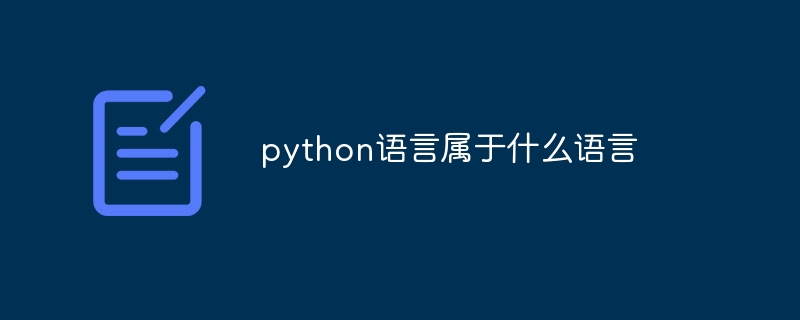What language does python language belong to?
The Python language is an interpreted high-level programming language. Its characteristics include: Interpreted language: the code does not need to be compiled and is executed line by line by the interpreter. High-level programming language: uses high-level abstract concepts, is highly readable, and easy to maintain. Dynamic typing: Variable type is determined at run time. Object-oriented: Supports object-oriented programming concepts. Scripting language: No compilation required, can be used for scripting and automating tasks. Extensive libraries: There are rich third-party libraries covering data science, machine learning and other fields.

Python language type
The Python language belongs to the interpreted high-level programming language.
Interpreted language:
- The code does not need to be compiled into machine code, but is executed line by line by the interpreter.
- Facilitates rapid development and debugging since there is no need to wait for the compilation process.
High-level programming language:
- Unlike low-level languages (such as assembly language), Python uses high-level abstract concepts such as classes, objects, and modules.
- It is highly readable and easy to maintain, and is suitable for solving complex problems.
Specifically, the Python language also has the following characteristics:
- Dynamic typing: The variable type is determined at runtime , no need to declare in advance.
- Object-oriented: Supports object-oriented programming concepts such as objects, classes, and inheritance.
- Scripting language: Typically used for writing scripts and automating tasks, which can be run without compilation.
- Extensive libraries: has a rich set of third-party libraries covering many fields such as data science, machine learning, and web development.
These features make Python a versatile and easy-to-use programming language suitable for a variety of applications, including:
- Data analysis
- Machine Learning
- Web Development
- Automated Tasks
- Scientific Computing
The above is the detailed content of What language does python language belong to?. For more information, please follow other related articles on the PHP Chinese website!

Hot AI Tools

Undresser.AI Undress
AI-powered app for creating realistic nude photos

AI Clothes Remover
Online AI tool for removing clothes from photos.

Undress AI Tool
Undress images for free

Clothoff.io
AI clothes remover

Video Face Swap
Swap faces in any video effortlessly with our completely free AI face swap tool!

Hot Article

Hot Tools

Notepad++7.3.1
Easy-to-use and free code editor

SublimeText3 Chinese version
Chinese version, very easy to use

Zend Studio 13.0.1
Powerful PHP integrated development environment

Dreamweaver CS6
Visual web development tools

SublimeText3 Mac version
God-level code editing software (SublimeText3)

Hot Topics
 How to solve the permissions problem encountered when viewing Python version in Linux terminal?
Apr 01, 2025 pm 05:09 PM
How to solve the permissions problem encountered when viewing Python version in Linux terminal?
Apr 01, 2025 pm 05:09 PM
Solution to permission issues when viewing Python version in Linux terminal When you try to view Python version in Linux terminal, enter python...
 How to teach computer novice programming basics in project and problem-driven methods within 10 hours?
Apr 02, 2025 am 07:18 AM
How to teach computer novice programming basics in project and problem-driven methods within 10 hours?
Apr 02, 2025 am 07:18 AM
How to teach computer novice programming basics within 10 hours? If you only have 10 hours to teach computer novice some programming knowledge, what would you choose to teach...
 How to avoid being detected by the browser when using Fiddler Everywhere for man-in-the-middle reading?
Apr 02, 2025 am 07:15 AM
How to avoid being detected by the browser when using Fiddler Everywhere for man-in-the-middle reading?
Apr 02, 2025 am 07:15 AM
How to avoid being detected when using FiddlerEverywhere for man-in-the-middle readings When you use FiddlerEverywhere...
 How to efficiently copy the entire column of one DataFrame into another DataFrame with different structures in Python?
Apr 01, 2025 pm 11:15 PM
How to efficiently copy the entire column of one DataFrame into another DataFrame with different structures in Python?
Apr 01, 2025 pm 11:15 PM
When using Python's pandas library, how to copy whole columns between two DataFrames with different structures is a common problem. Suppose we have two Dats...
 How does Uvicorn continuously listen for HTTP requests without serving_forever()?
Apr 01, 2025 pm 10:51 PM
How does Uvicorn continuously listen for HTTP requests without serving_forever()?
Apr 01, 2025 pm 10:51 PM
How does Uvicorn continuously listen for HTTP requests? Uvicorn is a lightweight web server based on ASGI. One of its core functions is to listen for HTTP requests and proceed...
 How to dynamically create an object through a string and call its methods in Python?
Apr 01, 2025 pm 11:18 PM
How to dynamically create an object through a string and call its methods in Python?
Apr 01, 2025 pm 11:18 PM
In Python, how to dynamically create an object through a string and call its methods? This is a common programming requirement, especially if it needs to be configured or run...
 How to solve permission issues when using python --version command in Linux terminal?
Apr 02, 2025 am 06:36 AM
How to solve permission issues when using python --version command in Linux terminal?
Apr 02, 2025 am 06:36 AM
Using python in Linux terminal...
 How to handle comma-separated list query parameters in FastAPI?
Apr 02, 2025 am 06:51 AM
How to handle comma-separated list query parameters in FastAPI?
Apr 02, 2025 am 06:51 AM
Fastapi ...






